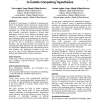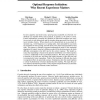118 search results - page 2 / 24 » Why computerized models to control virtual Humans |
CHI
2005
ACM
14 years 6 months ago
2005
ACM
In studies of virtual teams, it is difficult to determine pure effects of geographic isolation and uneven communication technology. We developed a multi-agent computer model in Ne...
IJVR
2007
13 years 5 months ago
2007
—This article describes the design of the two application scenarios of the Virtual Human project and its integration into the Virtual Human system. This includes overall concepts...
IVA
2005
Springer
13 years 11 months ago
2005
Springer
Abstract. Continuous and synchronized whole-body motions are essential for achieving believable autonomous virtual humans in interactive applications. We present a new motion contr...
NIPS
2008
13 years 7 months ago
2008
In most cognitive and motor tasks, speed-accuracy tradeoffs are observed: Individuals can respond slowly and accurately, or quickly yet be prone to errors. Control mechanisms gove...
IEAAIE
2009
Springer
14 years 9 days ago
2009
Springer
A computational agent model for monitoring and control of a virtual human agent’s resources and exhaustion is presented. It models a physically grounded intelligent decision maki...


